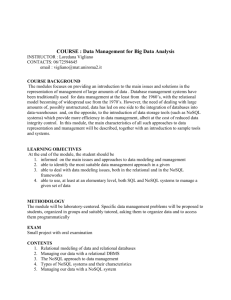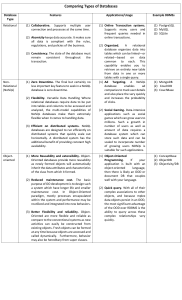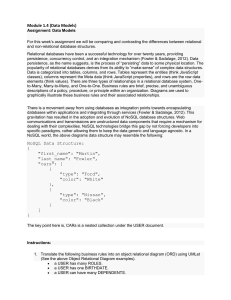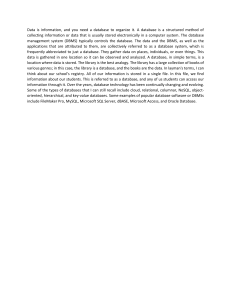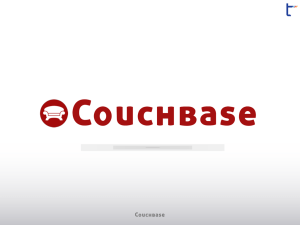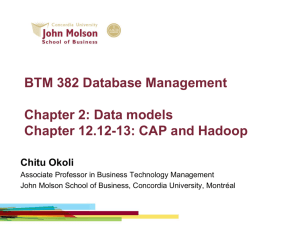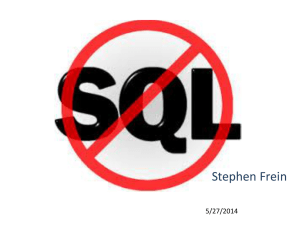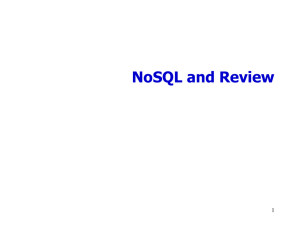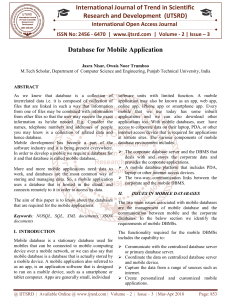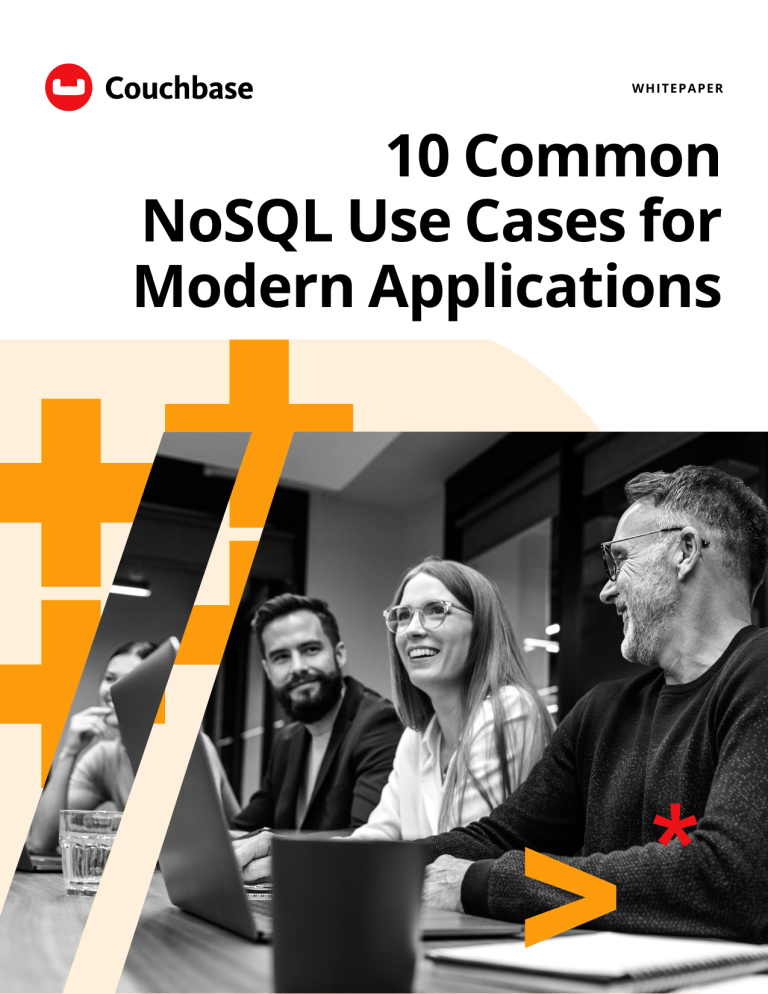
WHITEPAPER 10 Common NoSQL Use Cases for Modern Applications Table of Contents EXECUTIVE SUMMARY 5 NoSQL, now ready for prime time 5 From internet to enterprise 5 NoSQL powers revenue-driving, customer-facing applications 5 10 common use cases 6 Key takeaways 6 INTRODUCTION 6 A new era of enterprise database infrastructure 6 What’s driving NoSQL: mega-trends and new business requirements 6 Overcoming the challenges—and costs—of relational databases 7 PERSONALIZATION 7 Relational databases are overwhelmed by the volume of data required for personalization 7 Rigid schemas of relational databases make it difficult to build and update profiles on the fly 8 Relational databases are unable to deliver the low latency required for real-time responsiveness 8 PROFILE MANAGEMENT 9 NoSQL scale-out architecture enables faster, easier, more affordable scalability 9 NoSQL document databases provide flexibility to handle changing data types 9 Customer Spotlight 9 NoSQL with integrated cache delivers faster read/write performance than relational 10 Customer Spotlight 10 AUGMENTED REAL-TIME ANALYTICS 11 Operational and analytical databases need to work together 11 Modern data infrastructure: NoSQL database with stream processing 11 W H I T E P AP ER 2 CONTENT MANAGEMENT 12 Relational databases struggle to manage diverse content types due to their fixed data model 12 Flexibility of document-oriented, NoSQL databases supports any type of content 12 Customer Spotlight 12 Content management requires high performance and scalability, pushing the limits of relational databases 13 Customer Spotlight 13 CATALOG 14 Rigid schema of relational databases makes data aggregation difficult 14 NoSQL, document-oriented database enables on-the-fly data model changes 14 Relational databases are challenged to deliver high-performance read access 14 Customer Spotlight 15 CUSTOMER 360 VIEW 16 Use of relational databases leads to fragmented customer data 16 Relational databases are limited by their scale-up architecture 16 Relational databases struggle to deliver sub-millisecond response times 16 MOBILE APPLICATIONS 17 Scale-out architecture of NoSQL enables elastic, affordable scalability 17 NoSQL data model flexibility allows faster time to develop and update mobile apps 17 Customer Spotlight 17 Mobile apps need to work with or without a network connection 18 INTERNET OF THINGS 19 IoT applications require real-time access to operational data 19 Relational databases struggle with the volume, velocity, and variety of IoT data 19 NoSQL technology is a better solution for IoT applications 19 Customer Spotlight 19 Customer Spotlight 20 W H I T E P AP ER 3 DIGITAL COMMUNICATION Digital communication apps require massive scalability—a weak point for relational databases 21 21 Relational databases cannot deliver real-time responsiveness required for digital communications 21 Meeting the need for always-on availability 21 FRAUD DETECTION 22 Sub-millisecond responsiveness required for real time fraud detection 22 Customer Spotlight 22 Massive scalability requirements 23 Always on availability is a must 23 Customer Spotlight 23 CONCLUSION Four key takeaways 24 24 W H I T E P AP ER 4 EXECUTIVE SUMMARY NoSQL, now ready for prime time Over the last decade, NoSQL database technology has experienced explosive growth and accelerating use by large enterprises for mission critical applications. For example: • Tesco uses NoSQL to support its catalog, pricing, inventory, and coupon applications • MOLO17 uses NoSQL to streamline search and rescue efforts for the Barcolana regatta • Sky uses NoSQL to manage user profiles for 20 million subscribers • Crew Clothing uses NoSQL to reinvent its in-person shopping experience with a fully mobile hand-held sales solution • Nexon uses NoSQL to provide a consistent experience for gamers • Dominos uses NoSQL to formulate highly targeted campaigns to incentivize customers • PepsiCo uses NoSQL so that 30,000 users can perform operations without disruption • Marriott turns to NoSQL to deliver personalized customer experiences for each guest From internet to enterprise What’s remarkable about that list—which are just a few examples from hundreds of enterprises deploying NoSQL—is the variety of organizations and industries OVER THE LAST DECADE, NOSQL DATABASE TECHNOLOGY HAS represented. When NoSQL pioneers first deployed the technology, its use was limited to Internet-age companies like Google, Amazon, Facebook, and LinkedIn. Today, enterprises across virtually every industry are deploying NoSQL. In short, NoSQL is now ready for enterprise prime time. EXPERIENCED EXPLOSIVE GROWTH AND ACCELERATING USE BY LARGE ENTERPRISES FOR MISSION CRITICAL APPLICATIONS. NoSQL powers revenue-driving, customer-facing applications Major enterprises are deploying NoSQL for customer-facing, revenue-driving applications that serve hundreds of millions of consumers, business customers, and citizens. They’re turning to NoSQL to overcome limitations of decades-old relational database technology. And they’re choosing open source NoSQL over proprietary relational products from providers like Oracle, IBM, and Microsoft—in many cases, replacing those databases with NoSQL—at a fraction of the cost. W H I T E P AP ER 5 10 common use cases This document provides a guide to 10 common NoSQL use cases for modern applications we’re seeing in the market today. We based the list on our expertise and conversations with customers and prospects over the past decade. The use cases are: • Personalization • Customer 360° Views • Profile Management • Mobile Applications • Augmented Real-time Analytics • Internet of Things • Content Management • Digital Communication • Catalog • Fraud Detection Key takeaways For both business and technology decision makers, there are four key takeaways from this document: 1. NoSQL adoption has moved beyond experimenters and innovators to mainstream “early adopters” for mission critical applications 2. NoSQL is being adopted by major companies in virtually every industry for a broad and expanding set of use cases 3. Early adopters are realizing significant, quantifiable benefits and first-mover advantages: improved application performance, easier and more affordable scalability, faster development cycles, and more efficient resource utilization 4. NoSQL is now a fundamental cornerstone of modern, augmented real-time analytics infrastructure INTRODUCTION A new era of enterprise database infrastructure Based on our conversations with customers across every industry, nearly all of them assert that NoSQL is a critical component of their business. The top benefits they emphasize include improved application performance and availability as well as improved resource and operational efficiency. What’s driving NoSQL: mega-trends and new business requirements NoSQL adoption is being driven by both industry trends and business objectives. Major trends—the proliferation of mobile devices, the Internet of Things, real-time analytics, and cloud infrastructure—are raising the scalability and performance requirements for enterprise web and mobile applications, as the number of users, user expectations, and user interactions continue to grow. W H I T E P AP ER 6 NoSQL is enabling enterprises to increase business agility, achieve a faster time to market, and operate at a global scale while reducing costs. In addition, enterprises are modernizing database infrastructure by implementing database as a service (DBaaS) to meet the requirements of individual business units with and without multi-tenant cloud infrastructure, public or private, to improve resource and NOSQL IS ENABLING ENTERPRISES TO INCREASE BUSINESS AGILITY, ACHIEVE A FASTER TIME TO MARKET, AND OPERATE AT A GLOBAL SCALE WHILE REDUCING COSTS. operational efficiency. Overcoming the challenges—and costs— of relational databases These industry trends and business requirements present new challenges for traditional relational databases. Relational databases are difficult to scale, and they’re unable to guarantee the performance and availability necessary to meet increasing user expectations in the Internet age of always-on business. Whereas relational databases are limited by their “scale up” architecture—i.e., increasing the processing and storage capacity of a single server to support more users and operations—a NoSQL distributed database like Couchbase Server employs a “scale out” architecture that enables easy, affordable, on-demand scaling simply by increasing the number of servers. PERSONALIZATION Personalization is fast becoming an opportunity, and a challenge. It’s an opportunity to make the right engagement—an ad, a coupon, a recommendation, and more— with the right visitor at the right time. But the ability to ingest, process, and utilize the amount of data necessary to create personalized experiences is a challenge for relational databases. Relational databases are overwhelmed by the volume of data required for personalization A personalized experience requires data, and lots of it: Demographic, contextual, behavioral, and more. The more data available, the more personalized the experience. A significant source of data is clickstream data—i.e., high volume, high velocity data—the type of write-intensive workload that overwhelms relational databases. In contrast, a distributed NoSQL database like Couchbase Server can elastically scale to meet the most demanding workloads. W H I T E P AP ER 7 Rigid schemas of relational databases make it difficult to build and update profiles on the fly After ingesting visitor data, the next challenge is maintaining accurate visitor profiles. It’s not uncommon for visitor profiles to include hundreds if not thousands of attributes, as the number of attributes constantly grows. Increasing the number of attributes improves accuracy, but it can result in hundreds of millions of visitor profiles. While relational databases rely on fixed data models and offer limited scalability, document databases rely on flexible data models and provide unparalleled scalability. Relational databases are unable to deliver the low latency required for real-time responsiveness Finally, application logic must be able to access visitor profiles within milliseconds. The application must be able to engage visitors in real time. It’s not only a user expectation—it’s a business requirement. Advertisers, in particular, must meet service level agreements or else an ad will not result in an impression (and therefore no revenue) if it’s not delivered on time. And even more important than throughput is latency: While relational databases are limited to the speed of disk, a database like Couchbase Server, with integrated caching, can operate hundreds of times faster, at the speed of memory. KEY BUSINESS AND TECHNICAL REQUIREMENTS • Collect demographic, contextual, and behavioral data to increase visitor profile accuracy • Manage hundreds of millions of visitor profiles to improve visitor engagement • Continuously improve the accuracy of visitor profiles by adding new attributes COUCHBASE SERVER NOSQL SOLUTION • Document-level locking and high throughput, low latency writes supports massive number of concurrent visitors • Flexible data model based on JSON documents enables agile development • Managed, integrated object cache speeds read and write performance CUSTOMER HIGHLIGHTS • Carnival Corporation uses their OceanMedallion system, wearable IoT devices, to create highly personalized guest experiences • PayPal maintains over 1 billion identities and 650 million profiles to create personalized experiences [Case study] • Marriott supports 30 million documents, accessed at 4,000 transactions per second, to deliver personalized customer experiences for each guest [Case study] W H I T E P AP ER 8 Customer Spotlight Dominos creates personalized marketing campaigns with unified real-time data Dominos is a world leader in pizza delivery operating a network of company-owned and franchise-owned stores globally. One reason for Dominos’ continued growth and success is their focus on customers, and their realization that harnessing data could provide the best mechanism for driving loyalty and repeat business. The company created an omni-channel marketing system for the vast amount of data coming from POS systems all over the globe. Couchbase’s distributed architecture provided the company with the scale to serve every store worldwide. SQL support made it easy for legacy developers to adopt, and multi-model features allowed Dominos to process operational workloads, facilitate full text search, and analyze customer data within the same system. These capabilities combined to create a nimble system where analytic insights could be applied to operational situations almost immediately—now highly targeted campaigns no longer take weeks to formulate—recommendations are made in real time when they have the greatest likelihood to incentivize customers and drive increased business. [Case study] PROFILE MANAGEMENT User profile management is core to web and mobile applications. It enables online transactions, user preferences, user authentication, and more. As the number of users, complexity of user profile data, and user experience expectations accelerate, relational database technology struggles to keep up with scalability, data flexibility, and performance requirements. NoSQL scale-out architecture enables faster, easier, more affordable scalability Today, web and mobile applications support thousands if not millions—or even hundreds of millions—of users. While relational databases serve user profile data with a single server, distributed databases deploy multiple servers: Capacity is increased simply by adding servers, making it far easier and less expensive to scale than with relational databases. TODAY, WEB AND MOBILE APPLICATIONS SUPPORT THOUSANDS IF NOT MILLIONS—OR EVEN NoSQL document databases provide flexibility to handle changing data types User profile complexity is also increasing with advances in technology, new features and services, and the desire to leverage more data—e.g., demographics, preferences, HUNDREDS OF MILLIONS— history, behavior, and more. While user profiles in relational databases are defined OF USERS. by rigid data models—which means complex and time-consuming schema changes when new attributes or data types are added—document databases support dynamic data models, enabling fast and easy changes on the fly. W H I T E P AP ER 9 NoSQL with integrated cache delivers faster read/write performance than relational Finally, the availability of broadband Internet, the evolution of web browsers, and the rise of mobile apps have led users to expect an immediate response when they create a profile or login. While relational databases rely on separate caches to improve read performance—resulting in more expensive, complex, and harder to manage solutions—Couchbase Server features an easy-to-manage, integrated cache that delivers blazing fast read and write performance. KEY BUSINESS AND TECHNICAL REQUIREMENTS • Meet user experience expectations with high performance access to user profiles • Scale to support continuous increase in both the number of users and the number of user interactions • Leverage user profiles to improve engagement by adding new attributes on demand COUCHBASE SERVER NOSQL SOLUTION • Managed, integrated object cache delivers high read/write performance • Flexible data model based on JSON documents enables agile development • Scale out architecture, with an integrated admin console, enables “push button” scaling on demand CUSTOMER HIGHLIGHTS • Jam City scaled Couchbase Server to support the success of Cookie Jam, a title that exceeded 35 million users in under 8 months [Case study] Customer Spotlight Nexon is achieving faster time to market with Couchbase Capella Nexon is a global leader in virtual world games and massively multiplayer online roleplaying games (MMORPG), with over 80 game titles worldwide. Nexon knew their next title, BlueArchive, was likely to be another hit. The company needed the scalability to meet demand while having flexibility to roll out the game to new markets quickly as the title expanded to more users. With Capella, Couchbase’s database-as-a-service, developers are able to use their existing expertise to accelerate development. Couchbase’s JSON document model made it easy to evolve user profiles on-the-fly, making for painless updates. The speed and scale proved more than capable to meet the demands of gamers, making them more loyal, and the distributed architecture and easy provisioning enabled Nexon to roll out the game to new markets in minutes vs days, increasing its global reach and popularity. [Case study] W H I T E P AP ER 10 AUGMENTED REAL-TIME ANALYTICS The ability to extract information from operational data in real time is critical for an agile enterprise—in particular, the ability to increase operational efficiency, reduce costs, and increase revenue by acting on current data immediately. NoSQL is engineered for real-time analytics. Operational and analytical databases need to work together In the past, operational databases and analytical databases were maintained as different environments. The operational database powered applications. The analytical database was part of the business intelligence and reporting environment. They were not well integrated. They relied on a slow and complex process to load data from the operational database into the analytical database. The analytical database was never current. Modern data infrastructure: NoSQL database with stream processing Today, enterprises are moving from batch processing to stream processing. While batch processing is slow and incremental, stream processing is fast and continuous. A stream processor analyzes data the moment it’s generated, but it doesn’t provide access to the results, which is necessary for enterprises to take action. That’s why a NoSQL database is necessary—as a front-end to store and manage operational data from any source and feed data to other systems, as well as a back-end to receive, store and serve analytic results. As a result of these requirements, modern real-time analytics infrastructure integrates a NoSQL database with a stream processor. TODAY, ENTERPRISES ARE MOVING FROM BATCH PROCESSING TO STREAM PROCESSING. WHILE BATCH PROCESSING IS SLOW AND INCREMENTAL, STREAM PROCESSING IS FAST AND CONTINUOUS. KEY BUSINESS AND TECHNICAL REQUIREMENTS • Act on new data as soon as possible to improve operational efficiency • Make actionable information available via dashboards and other real-time applications • Maintain a single solution that meets both operational and analytical requirements COUCHBASE SERVER NOSQL SOLUTION • Integrates with distributed messaging and stream processing systems • Memory-centric architecture delivers high speed reads and writes to meet constantly growing performance requirements CUSTOMER HIGHLIGHTS • Dominos uses real-time data to formulate highly targeted campaigns to incentivize customers [Case study] • LivePerson processes terabytes of continuous clickstream data to monitor visitors in real-time W H I T E P AP ER 11 Customer Spotlight PayPal monitors site traffic in real time with NoSQL PayPal uses Couchbase Server to build the foundation of its real-time analytics platform. Clickstream and interaction data from all channels is pushed to the platform for real-time analysis. The data is pulled in a stream processor for filtering, enrichment, and aggregation. After the data is processed, it’s written to Couchbase Server where it’s accessed by rich visualization tools. With these tools, PayPal can monitor all traffic in real-time. In addition, PayPal leverages views in Couchbase Server to perform additional aggregation and filtering. [Case study] CONTENT MANAGEMENT Regardless of industry, every enterprise needs to engage users with rich, informative content. It’s a fundamental requirement of doing business today. Content isn’t limited to text or neatly structured data. It includes all kinds of semi- and unstructured data: Images, audio, video, presentations, and much more. And it’s not limited to content produced by the brand—it includes user-generated content such as photos, videos, reviews, ratings, and comments. Relational databases struggle to manage diverse content types due to their fixed data model The key to effective content is combining it—the ability to select a variety of content, aggregate it, and present it to the customer at the moment of interaction. But due to the fixed data model in relational databases, it’s difficult to create, maintain, and modify content like product pages, support portals, knowledge bases, and online magazines using relational technology. It’s not easy to add new types of content, because it requires a new data model, nor is it easy even to add new attributes, since it requires changes to the data model. Flexibility of document-oriented, NoSQL databases supports any type of content By contrast, a NoSQL document database, with its flexible data model, is perfect for storing rich, complex content. It can store and provide access to any type of content—structured, semi- or unstructured—because it does not require the data model to be defined first. This not only enables enterprises to easily create and produce new types of content, it also enables them to incorporate user-generated content—such as comments, images, or videos posted on social media—with the same ease and agility. W H I T E P AP ER 12 Content management requires high performance and scalability, pushing the limits of relational databases It’s one thing to store content; it’s another to serve it. To be effective, applications have to deliver content to users immediately. For relational databases, this can be difficult as both the number of users and the amount of content increases. While relational databases are limited to how many users and how much content they can store on a single server, a distributed NoSQL database like Couchbase Server is not COUCHBASE SERVER SCALES limited. Couchbase Server scales out simply by adding more servers. And with its OUT SIMPLY BY ADDING integrated cache, Couchbase Server provides extremely high read performance by MORE SERVERS. AND WITH serving content at the speed of memory. ITS INTEGRATED CACHE, KEY BUSINESS AND TECHNICAL REQUIREMENTS COUCHBASE SERVER PROVIDES • Support the creation of new types of compelling content without administration EXTREMELY HIGH READ overhead PERFORMANCE BY SERVING • Engage customers by presenting them with a variety of content in multiple formats CONTENT AT THE SPEED OF • Meet user expectations, web or mobile, by providing immediate access to the MEMORY. latest content COUCHBASE SERVER NOSQL SOLUTION • Flexible data model, based on JSON documents, stores any kind of content— structured, semi- and unstructured • Integrated cache provides high throughput, low latency access to content • Scale out architecture supports large volumes of content simply by adding servers on demand Customer Spotlight Sky keeps 22 million subscribers happy with high performance and availability Sky, Europe’s largest media company and TV broadcaster, uses Couchbase to keep compelling content available during peak demand for over 22 million subscribers. Sky has to stay a step ahead of constant technology challenges like streaming content, which put ever-increasing demands on their database. Frustrated with the scalability and performance limitations of their legacy Oracle RDBMS, Sky started its digital transformation by migrating its identity platform to Couchbase, which provides full sign-up and sign-in functionality for all Sky’s online products. XDCR transfers data to multiple datacenters, reducing sign-in response time by 50% and dropping the recovery time from hours to minutes. [Case study] W H I T E P AP ER 13 CATALOG Catalogs are not only referenced by web and mobile applications, they enable point-of-sale terminals, self-service kiosks, and more. In addition to product and service catalogs, there are reference catalogs for financial assets, employee data, digital media, and more. Catalogs may often contain user-generated content such as images, reviews, ratings, and comments. Rigid schema of relational databases makes data aggregation difficult As enterprises offer more products and services and collect more reference data, catalogs become fragmented by application and business unit or brand. Because relational databases rely on fixed data models, it’s not uncommon for multiple applications to access multiple databases—which introduces complexity and data management challenges. By contrast, a NoSQL document database, with its flexible data model, enables enterprises to more easily aggregate catalog data within a single database. NoSQL, document-oriented database enables on-the-fly data model changes Catalogs are also dynamic. Adding new products and services may require changes to the data model and new attributes, if not entirely new data models. The same is true for new features such as recommendations, promotions, and more. While relational databases are limited to static data models—which are complex and timeconsuming to change—a document database enables on-the-fly updates to the data model, and thus dynamic catalogs. Relational databases are challenged to deliver highperformance read access Applications require high-performance read access to catalogs from multiple channels—point-of-sales, kiosk, web, mobile, and more—to support millions of users, which is a challenge for relational databases. A delay in accessing product information could cause a line to form at a checkout terminal or visitors to abandon a website or shopping cart. Couchbase Server addresses those requirements with its memory-centric architecture and automatic replication to ensure high performance and availability. A case in point: While many retailers struggled to maintain availability during Black Friday and Cyber Monday, one of the world’s largest megaretailers who deployed Couchbase Server didn’t experience those problems and set record online sales. W H I T E P AP ER 14 KEY BUSINESS AND TECHNICAL REQUIREMENTS • Store catalog data for multiple applications and business units/brands within in a single database • Add new products, services, and reference data or features that rely on them, on demand • Ensure catalog data is available to applications during peak periods COUCHBASE SOLUTION • Flexible data model based on JSON documents enables fast, agile development • Managed, integrated object cache provides low-latency read performance • Scale out architecture, with an integrated admin console, enables “push button” scaling on demand CUSTOMER HIGHLIGHTS • Amadeus maintains the world’s largest database of travel related data and processes more than 2 million requests/second with Couchbase Server [Case study] • Tommy Hilfiger delivers a smooth, immersive showroom experience that works flawlessly even if the internet goes down [Case study] Customer Spotlight NoSQL powers product catalogs and more for mega-retailer Tesco Tesco, the world’s largest Europe-based retailer, is adopting Couchbase Server for multiple use cases, including a centralized service for storing and managing data for millions of products, which can be leveraged across the company. Other targeted use cases for Couchbase Server include NoSQL databases to power pricing and inventory management applications, as well as an application to deliver customer-specific coupons and vouchers at the point of sale and on the website, and a customer orders database to track purchase history across all channels. Tesco is migrating to Couchbase’s distributed NoSQL platform in order to provide the flexibility to accommodate a diverse range of fast-changing data, as well as the performance, availability, and scalability to support massive numbers of users, large amounts of data, and very high throughput requirements. As Tesco’s requirements grow, Couchbase Server provides easy, push button scalability, allowing the retailer to simply add nodes on demand as system capacity and throughput needs increase. [Case study] W H I T E P AP ER 15 CUSTOMER 360 VIEW Creating and maintaining a unified view of the customer has been an important but elusive goal for enterprises. Customers expect a consistent experience, regardless of channel. And the enterprise wants to capitalize on upsell/cross-sell opportunities and provide the highest level of customer service in a cost effective manner. However, as the number of products and services, channels, brands, and business units increases, customer data becomes fragmented in silos. Use of relational databases leads to fragmented customer data The fixed data model of relational databases forces enterprises to fragment customer data, because different applications work with different customer data. As a result, these applications end up maintaining their own data model and a separate view of the customer. In contrast, a NoSQL document database utilizes a flexible WHEN IT COMES TO CUSTOMER INTERACTIONS, PERFORMANCE MATTERS. data model that enables multiple applications to not only access the same customer data, but to add new attributes without affecting other applications. Relational databases are limited by their scale-up architecture As the number of customers grows from thousands to millions—and even hundreds of millions or more—enterprises need a scalable database to address not only a high volume of customer data, but a high number of customer interactions. While relational databases are limited to the resources of a single server (a “scale up” architecture), a distributed database can scale simply by increasing the number of servers (a “scale out” architecture). So as the number of customers grows, enterprises can just add servers on an as-needed basis. Relational databases struggle to deliver sub-millisecond response times When it comes to customer interactions, performance matters. Whether trying to make a purchase, view a billing statement online, or call for support, customers expect an immediate response. Unlike relational databases that rely on third-party caching solutions, Couchbase Server, with its integrated cache, can natively provide submillisecond response times required to deliver a great customer experience. KEY BUSINESS AND TECHNICAL REQUIREMENTS • Ensure a high quality experience for every customer via any channel—online, on the phone, or in-store • Improve operational efficiency by maintaining a complete, consistent view of customer data • Meet user expectations, web or mobile, for millions of customers W H I T E P AP ER 16 COUCHBASE SERVER NOSQL SOLUTION • Flexible, JSON-based data model supports the needs of multiple applications • Integrated cache enables high throughput, low latency access to customer data • Scale out architecture allows storage of large volumes of customer data by adding servers on demand Customer Spotlight CenterEdge Software gives customers fast, flexible search capabilities in the cloud CenterEdge provides amusement parks and other family entertainment centers with software solutions for 360-degree customer insights at the point-of-sale, online ticketing, and other essential business functions. First, CenterEdge used Couchbase to move its source of truth database to the cloud. Then they took advantage of Couchbase’s Full- Text Search to give their clients lightning-fast search capabilities across millions of customer records. Couchbase also indexes data rapidly, so customers immediately see updates across all their applications. [Case study] MOBILE APPLICATIONS Mobile phones and tablets are rapidly becoming the dominant platform for search, shopping, and other applications. Mobile users spend only 20% of their time in browsers and 80% within apps. Mobile applications present challenges with scalability, performance, and availability that relational databases are ill equipped to address. Scale-out architecture of NoSQL enables elastic, affordable scalability With nearly 2 billion smartphone users, mobile applications face scalability challenges in terms of growth and volume. For instance, it’s not uncommon for mobile games to reach tens of millions of users in a matter of months. With a distributed, scale-out database, mobile applications can start with a small deployment and expand as the user base grows, rather than deploying an expensive, large relational database server from the beginning. NoSQL data model flexibility allows faster time to develop and update mobile apps A flexible data model is critical for mobile applications. In a market where applications go viral, time to market is essential. By adopting a flexible data model, mobile apps can be developed faster and launched sooner. In addition, a fixed data model can make it difficult to support multiple versions of a mobile application W H I T E P AP ER 17 because different versions may have different data models. A document database solves this problem by enabling developers to create and maintain a single, flexible data model that can change and evolve on the fly, without the need to redefine schema beforehand. Mobile apps need to work with or without a network connection Users expect mobile applications to be highly interactive and highly responsive. This creates performance and availability challenges. The database must respond within milliseconds regardless of the number of users. However, a remote database in the cloud requires a network connection. For a mobile application to be available without a connection, it needs a local database and automatic synchronization with the remote database. Couchbase Mobile solves this challenge by extending Couchbase Server to mobile phones and tablets to support offline access. COUCHBASE MOBILE KEY BUSINESS AND TECHNICAL REQUIREMENTS ENABLES OFFLINE DATA • Support viral growth (e.g., tens of millions of users within days or months) in a ACCESS WITH AUTOMATIC cost effective manner SYNCHRONIZATION TO DELIVER • Launch new mobile applications with a faster time to market APPS THAT ALWAYS WORK • Provide users with a smooth, seamless experience, online or offline WITH OR WITHOUT A NETWORK CONNECTION COUCHBASE SERVER NOSQL SOLUTION • Scale out architecture, with an integrated admin console, enables “push button” scaling on demand • Flexible data model based on JSON documents enables agile development • Couchbase Mobile enables offline data access with automatic synchronization to deliver apps that always work with or without a network connection CUSTOMER HIGHLIGHTS • Cookie Jam by SGN and Facebook Game of the Year scaled to 35 million users in under eight months [Case study] • Draw Something by Zynga, scaled from 6 to 90 nodes in 8 weeks to support 15 million daily users • BackpackEMR has reduced manual processes by 25% and increased the number of patients seen by 30% [Case study] • Crew Clothing processes 85% of total transactions through their new mobile solution, vastly improving the customer experience and decreasing staff turnover by 22% due to a reduced workload [Case study] W H I T E P AP ER 18 Customer Spotlight MOLO17 helps streamline rescue efforts for safer sailing MOLO17 is a Couchbase partner that securely unlocks enterprise data potential with 100% uptime and uninterrupted business continuity. When the MOLO17 team was approached by Insiel SpA to build a location tracking and communication application for Barcolana, the world-renowned regatta in the Gulf of Trieste, they turned to Couchbase’s fully managed backend designed for mobile, IoT, and edge applications—Capella App Services on AWS. Capella App Services provides a cloud database, an embeddable mobile database, and automatic synchronization between the two—making it the perfect technology for this critical safety and rescue application. Now regatta participants can be rescued in a fraction of the time it would take previously. [Case study] INTERNET OF THINGS Today, some 20 billion devices are connected to the Internet—everything from smartphones and tablets to home appliances and systems installed in cars, hospitals, and warehouses. These devices receive data on environment, location, movement, temperature, weather, and more from 50 billion sensors. This data can be leveraged by enterprises in manufacturing, health care, retail, security, transportation, and TODAY, SOME 20 BILLION DEVICES ARE CONNECTED TO THE INTERNET—EVERYTHING FROM SMARTPHONES AND TABLETS TO HOME APPLIANCES AND SYSTEMS INSTALLED IN CARS, HOSPITALS, AND WAREHOUSES. many other industries. IoT applications require real-time access to operational data Innovative enterprises are leveraging the Internet of Things to develop new products and services, reduce costs and time to market, increase efficiency, eliminate waste, and boost customer satisfaction. This ability to access global, operational data in real-time enables dynamic, informed decision-making and increases business agility. Relational databases struggle with the volume, velocity, and variety of IoT data The volume, velocity, and variety of machine-generated data—a major contributor to the growth of data and the Internet of Things—are increasing with the proliferation of digital elementary, which is semi-structured and continuous. Relational databases struggle with the three well-known challenges from real-time IoT applications: scalability (due to massive volumes of data), throughput (due to super fast data velocity), and data variety (structured and semi-structured). NoSQL technology is a better solution for IoT applications To overcome these challenges, innovative enterprises are relying on NoSQL technology like Couchbase Server to scale concurrent data access to millions W H I T E P AP ER 19 of connected devices and systems, store large volumes of data, and meet the performance requirements of mission-critical infrastructure and operations. Couchbase Server provides the scalability to manage billions of data points, the speed and throughput necessary to ingest continuous streams of data in real-time, and the flexibility to store data that’s evolving every day. KEY BUSINESS AND TECHNICAL REQUIREMENTS • Leverage IoT data to create new products and services • Improve operational efficiency by collecting data from machines, equipment, and more • Interact with connected devices in multiple geographic locations COUCHBASE SERVER NOSQL SOLUTION • Document-level locking and memory-first writes support massive number of concurrent devices • Flexible data model based on JSON documents supports new types of IoT data • Built-in, streaming cross data center replication brings database closer to connected devices and end users • Couchbase Mobile removes dependency on network access to continuously collect and store data CUSTOMER HIGHLIGHTS • Facet Digital reduced total cost of ownership by 50% and increased query performance by as much as 2000%—from hours to minutes—with Capella [Case study] Customer Spotlight Verizon utilizes IoT to better connect the world Verizon operates America’s most reliable wireless network, with 118 million retail connections nationwide, providing high performance at scale for billions of data points with automated sync between devices and the cloud. The company also provides communications and entertainment services via mobile broadband and a premiere all-fiber network. For businesses, Verizon delivers integrated solutions to customers worldwide. Verizon’s ThingSpace is an innovative end-to-end IoT development platform that helps enterprise customers build and deploy IoT solutions. Devices on the ThingSpace platform can take advantage of services such as connectivity management, device management, reporting and analytics, and security and compliance. [Case study] W H I T E P AP ER 20 DIGITAL COMMUNICATION Today’s world relies on digital communication in the form mobile text messaging, online chat, real-time collaboration, and more. However, enabling millions of users to communicate in real-time requires both performance and availability at scale, and it’s a challenge for relational databases. Digital communication apps require massive scalability—a weak point for relational databases Mobile text messaging applications are hugely popular. They have to support millions if not hundreds of millions of users. That means hundreds of thousands to millions of requests per second, and users expect immediate responses. It’s not acceptable to wait seconds for a message to be sent. It must be sent within milliseconds. This type of write-intensive workload with many concurrent users is a challenge for relational databases. While the scalability of relational databases is limited to increasing the amount of memory or processors within a single server, a distributed NoSQL database like Couchbase Server easily and elastically scales as more servers are added. Relational databases cannot deliver real-time responsiveness required for digital communications In an enterprise environment, digital communication may take the form of online interaction via direct messaging to help visitors find a product or complete the checkout process. This type of online interaction must take place in real time. If it’s delayed, visitors may abandon the website before a representative can interact with them. And as with mobile text messaging, the application may need to support millions of website visitors. While the responsiveness of relational databases is limited by operating at the speed of disk, Couchbase Server, with its integrated cache and memory-centric architecture delivers the sub-millisecond responsiveness that digital communications applications require. Meeting the need for always-on availability In a connected world, users are no longer confined to a specific region or country. In addition to being available 24 hours day, 365 days a year, digital communication platforms must be available to users in multiple regions and countries. While relational databases require third-party software for cross data center replication (XDCR)— resulting in a slow and complex solution—Couchbase Server features integrated, streaming XDCR for high availability, disaster recovery, and data locality. KEY BUSINESS AND TECHNICAL REQUIREMENTS • Enable millions of users to send and receive messages in real-time • Ensure digital communication platforms are available 24x365 • Support a global user base with users in multiple regions and countries W H I T E P AP ER 21 COUCHBASE SERVER NOSQL SOLUTION • Flexible data model based on JSON documents enables agile development • Managed, integrated object cache delivers high read/write performance • Scale out architecture, with an integrated admin console, enables “push button” scaling on demand CUSTOMER HIGHLIGHTS • LivePerson replaced Cassandra with Couchbase Server to manage 20M+ engagements per month Customer Spotlight Viber gains the scalable performance to process up to 15 billion events per day The Viber app connects more than 1 billion users worldwide through high-quality audio and video calls, messaging, and more. To process up to 15 billion events per day, Viber needs scalable database performance. The company implemented Couchbase in a multi-layered AWS architecture. Couchbase updates user profiles in near-real time, delivering a responsive user experience. By replacing MongoDB™ and Redis with a single Couchbase database, Viber also reduced the number of servers from 300 to 120—simplifying the architecture and reducing overall total cost of ownership. [Case study] FRAUD DETECTION For financial services enterprises, fraud detection and risk analytics are essential to reducing profit loss, minimizing financial exposure, and complying with regulations. The process impacts both the enterprise and its customers: It relies on data—rules, customer information, transaction information, location, time of day, and more— FOR FINANCIAL SERVICES ENTERPRISES, FRAUD DETECTION AND RISK ANALYTICS ARE ESSENTIAL TO REDUCING PROFIT LOSS, MINIMIZING FINANCIAL EXPOSURE, AND COMPLYING WITH REGULATIONS. applied at scale and in real-time. Sub-millisecond responsiveness required for real time fraud detection When customers pay with a credit or debit card online or in-person, they expect immediate confirmation. However, the transaction must be processed by a fraud detection platform, which has to access customer data and fraud detection rules in less than a millisecond. It’s a low latency requirement that relational databases fail to meet. In contrast, Couchbase Server is able to provide data access at the speed of memory by leveraging an integrated cache. W H I T E P AP ER 22 Massive scalability requirements The financial services industry serves hundreds of millions of customers who perform billions of transactions per year, in real time. While the ability for relational databases to operate at this scale is expensive and limited, distributed databases rely on commodity hardware with no limits on operating scale. Always on availability is a must As a mission critical application, the availability and disaster recovery requirements for fraud detection are exceptionally high. Applications must run 24 hours a day, 365 days a year, and require availability across data centers. While relational databases rely on complex, slow software to replicate data to multiple data centers, Couchbase Server features integrated, streaming cross data center replication to increase availability and support disaster recovery. KEY BUSINESS AND TECHNICAL REQUIREMENTS • Apply fraud detections rules to financial transactions in real-time • Scale to support millions of card holders and billions of transactions • Ensure fraud detection platforms are running 24x365 COUCHBASE CAPELLA NOSQL SOLUTION • Managed, integrated cache enables sub-millisecond data access • Scales to support billions of transactions simply by increasing the number of nodes • Built-in, streaming cross data center replication delivers high availability and disaster recovery support Customer Spotlight FICO uses Couchbase to support the world’s #1 fraud detection platform Powered by Couchbase, FICO’s fraud detection platform scores 65% of the world’s credit/ debit cards. Downtime means fraud and lost revenue for the company, so when FICO was chosen to provide credit checks, fraud screening, and targeted offers for new telecommunications customers both in-store and online, it needed a NoSQL database that could deliver high availability alongside high transactional volume. Couchbase was chosen over Cassandra and MongoDB™ for speed, scalability, availability, and persistence to support large XML objects. [Case study] W H I T E P AP ER 23 CONCLUSION Four key takeaways This list of 10 common NoSQL use cases for modern applications, along with real world examples, illustrates the extent to which NoSQL has penetrated the enterprise. NoSQL has clearly caught the interest and imagination of both developers and business managers as a solution to key challenges that relational database technology simply was never designed to address. There are four key conclusions to take away from these use case examples: 1. NoSQL has advanced well beyond experimentation NoSQL adoption has clearly moved beyond experimenters and innovators to mainstream “early adopters” for mission critical applications. While it’s still early days in the NoSQL adoption cycle, enterprises are using NoSQL for mission critical applications that drive revenue and serve massive numbers of users. 2. NoSQL is being adopted in virtually every industry NoSQL adopters referenced in this document represent a very broad range of industries, from retail and financial services to travel, telecommunications, and government. Enterprises that need to develop and deploy large-scale enterprise web, mobile, and IoT applications—which includes pretty much every industry— are turning to NoSQL as a key part of the solution. 3. NoSQL adopters are realizing significant, measurable benefits Enterprises are reporting major, quantifiable benefits from their use of NoSQL. Most importantly, they’re solving problems that traditional relational databases cannot address. Among other benefits, NoSQL is enabling enterprises to deliver more responsive applications; scale their applications more affordably; increase resource efficiency; develop applications more quickly; and harness the value of data to better understand customers and improve their business. 4. NoSQL is a fundamental cornerstone for modern applications NoSQL has become a fundamental cornerstone of modern application architectures. Already we are seeing a number of forward-looking enterprises— those known for their early use of emerging technologies—“re-platform” their entire technology infrastructure in the cloud, and with NoSQL to build a new foundation that meets their growing distributed application requirements. Over the next several years, we expect to see this broad re-platforming taken to new heights. W H I T E P AP ER 24 Modern customer experiences need a flexible database platform that can power applications spanning from cloud to edge and everything in between. Couchbase’s mission is to simplify how developers and architects develop, deploy and consume modern applications wherever they are. We have reimagined the database with our fast, flexible and affordable cloud database platform Capella, allowing organizations to quickly build applications that deliver premium experiences to their customers—all with best-in-class price performance. More than 30% of the Fortune 100 trust Couchbase to power their modern applications. For more information, visit www.couchbase.com and follow us on Twitter. © 2023 Couchbase. All rights reserved.
